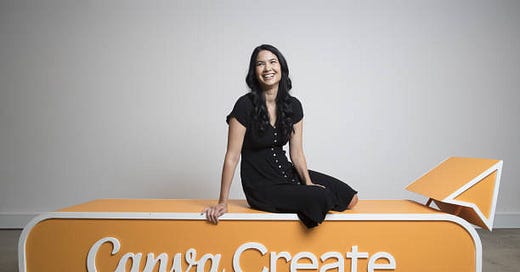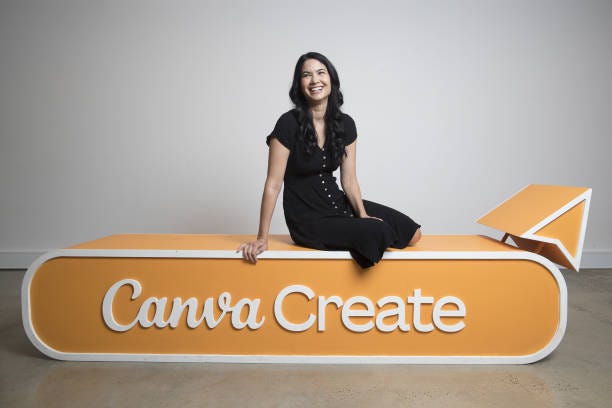I have an uncle who has hosted events for as long as I can remember. He has always DIYed the whole thing, from poster design, printing, to running the show.
Every time, the event flier would land in our inboxes like a bomb. You’d open it, and there it was: clashing fonts, images bleeding into text, and every detail crammed in like it was a fight for attention.
You’d almost feel sorry for him. But most times, we just laughed.
It became a running joke:
“At this point, he should just call us one by one and say what he needs to say. Our eyes can’t take it anymore.”
The joke ended around 2015, two years after Canva's launch, and he finally discovered it.
Suddenly, even my uncle could make something beautiful in minutes.
Canva's product refinement is a deeply personal journey for most people, even those who don't necessarily pause to think of it. Because with almost everyone and everything being online, aesthetic is a central part of our online experience now. From the moment someone has a great idea, to the time they take it to the world, chances are that idea passed through Canva for a dress up.
In one of her old recordings during the time they were still designing Canva, they were asking each other as a team what success would look like to each of them, and for Melanie, it would be when “If anyone thought of design, they thought Canva.” And “to build one of the world’s most viable companies.”
I love clarity like that at design stage because it forces you to answer important questions. To dream on behalf of the user an almost magic world and then package it into a tool. Canva’s magic studio among other things, was made with this in mind, to give a user the power to just tap, and bring the beauty in their brands to life.
The Odds Were Stacked
Source: Getty images
The very concept of Canva, which started off as Fusion Books, meant Melanie was setting out to take on tech giants like Adobe, and Microsoft. She didn't even have to make it her mission for it to be. She was coming with a product and user experience that if successful, would change the design world forever, and force other companies to play catch up.
But the problem with that, if you are 19, with no tech knowledge, and no financing, is that the distance between coming up with the idea and executing it at scale can be long—and anything can happen that could break you before your product ever hits the market. For one, a bigger company with both the talent and capital can adopt your idea before you do. Or, things can break, because if there is anything that makes tech products delicate and complex, it's how easy it is to build the software on a brittle spine, that makes scaling almost impossible. But to build better, you need just about the best people in the industry, which means you need money—and money, Melanie did not have.
Canva's Magic
This is where the magic comes.
With everything playing against her, Melanie's edge was how deeply she thought about the user. She had been teaching design part time at a university, and realized how clunky the design experience was for her students. You not only moved from tool to tool for each different use case, but each of these tools was built only for specialists. You had to have invested loads of time and gone through a steep learning curve to emerge a good designer. This was a bottleneck in a world that was fast going fully online. Bloggers and creators and others were living and breathing this bottleneck.
She wanted a tool where everything was in one place, where you simply dragged and dropped—and most of all, where you didn’t feel dumb. She noticed that the problem with difficult design interfaces wasn't only that it made design inaccessible to many, but also that when a user notices how much time they had put in trying to figure things out and still failing, they'd feel like they weren't that smart.
A design issue becomes an esteem issue.
And so her plan became to design for joy and confidence. A place where someone could feel like they were a darn good designer after only a few minutes of work. Her belief was that if she solved both the tangible problem, and the emotional one it came with, she would have created a tool people would come back to. That was the magic she baked into Canva. The root of what made her able to stand toe to toe with giants 1000x her size at the beginning—and what helps Canva maintain its foothold in the market today.
The Pay Off: Market Reception
When Canva finally launched, the market didn’t just use it. They loved it. And love is not a word people use lightly for software.
It landed as a solution that made people feel capable, modern, and seen. Design had always been a gate-kept skill, and now suddenly, it was in everyone’s hands. The beauty of what Canva did wasn’t just in its drag-and-drop simplicity. It was in how people felt when they used it. For many, it was the first time they saw something they created and thought, Wow, I made that.
That kind of emotional payoff travels fast. Canva became a silent co-pilot behind pitch decks, church announcements, wedding invitations, content calendars, and school projects. People didn’t just onboard. They evangelized. And when you build a tool that people talk about, not just use, your growth stops needing press releases and starts coming from group chats.
Four Years of Pitching. Four Years of Nos.
But none of that would’ve happened if they had stopped after the first hundred rejections.
Melanie and Cliff pitched for four straight years. Four years of almosts. Of rejections that came wrapped in compliments. “Interesting product, but...”, “Great team, but...”, “Come back when...”
They weren’t in Silicon Valley. They were building from Australia, which to some investors might as well have been the moon. That distance—both literal and cultural—meant they weren’t in the rooms where the cheques moved fast. It meant they had to be strategic. Every "no" became a data point. Every rejected deck became a stronger version of itself.
Their strategy wasn’t to charm their way in. It was to out-clarify everyone else.
And they didn’t do it alone. They brought in Cameron Adams, one of the original Google Maps guys. He became cofounder and product lead—and with him, they formed the kind of team investors couldn’t ignore for long. The kind that combined vision with execution.
Eventually, one of those pitches landed in front of Bill Tai, a legendary Silicon Valley investor known for his early bets on Zoom, Wish, and TweetDeck. But even Bill was cautious. He liked them, but liking founders doesn’t always equal funding. And he knew that saying yes or no would ripple out to the entire investor network watching.
That’s how high the stakes were.
After years of pitching him—and years of him insisting they build the right team—his yes finally came. But it came with just $25,000.
To them, it signaled low confidence.
And the last thing you want is to move forward with “Bill Tai has very low confidence in this pitch” basically written all over your deck.
Because in venture, the first yes isn’t just capital. It’s signaling. And a weak signal can kill momentum just as fast as a no.
So they pushed back, reframed and clarified. They reminded him of what they were building and who they were becoming.
And they walked out with $100,000 instead.
That was the unlock. Once Bill moved, others followed. The checks got bigger, and the yeses became louder than the nos.
But even then life didn’t smooth out.
Just before launch, Cameron was hit by a car while biking. He finished prep from the hospital. That kind of grit—that refusal to pause or fold—is part of what made the team work. And part of why Canva’s launch, in 2013, wasn’t just another product hitting the market. It was confidence, designed and shipped into the user's hands.
Lessons For Founders
1. Clarity Wins
Canva didn’t “eventually get lucky.” They got clearer. Over four years, every no became an opportunity to sharpen how they positioned their product, their team, and their market. They didn’t just take feedback—they coded it back into the business.
Action Step:
Treat rejections like user research. Create a simple Notion board where you log every investor “no,” including the exact objection, phrasing, and feedback. Then sort by theme. Are you hearing “too early,” “unclear market,” or “don’t see the moat”? Use that to reshape your pitch. Don’t aim to be liked—aim to be undeniable.
2. You're Not Just Raising Money—You're Engineering Signal.
The first “yes” matters because of who says it. When Bill Tai offered $25K, Melanie and Cliff knew taking it would tell a story—to the entire investment community—about how much confidence he had. A small check from a big name is still a message.
Action Step:
Before you start asking for money, make a list of possible investors. Don’t just focus on how much they can give—look at who they can influence.
Ask yourself:
Who are the key people that others follow?
Who has a history of spotting great ideas early?
Plan the order of your outreach so that getting a “yes” from the right people early on makes it easier to get more “yeses” later.
You’re not just raising money—you’re building momentum.
3. Know When to Push Back.
Many founders would have accepted that $25K and called it a win. Melanie and Cliff didn’t. They pushed in the meeting—because they knew a weak yes was more dangerous than a clean no.
Action Step:
Build a “minimum viable check size” policy before fundraising. Know what amount sends the wrong signal, and rehearse how you’ll push for more in real-time. Practice the script: “If we take this check at this level, it’ll set the tone for the rest of the round—and we’re building a narrative that needs weight early.”
4. Don’t Just Build Product—Build Investor Context.
They didn’t just meet Bill Tai once and hope he remembered them. They built context over years. That meant updates, momentum, evolution—and making him watch them grow from “smart idea” to “inevitable bet.”
Action Step:
Create a quarterly investor update—even if you haven’t raised yet. Keep a list of warm leads and past conversations. Every 90 days, send them traction, shifts, learnings, and team moves. You're not annoying them. You're building familiarity. The best yeses come from investors who feel like they've already seen your arc.
5. Team Is More Than Talent—It’s Narrative Armor.
Cameron Adams joining the founding team wasn’t just about product. It was signaling. It helped reframe the whole story: from “ambitious Australian startup” to “Google Maps alum bets on this.” That changed investor psychology.
Action Step:
When you bring on cofounders, advisors, or early hires—think beyond résumé. Think about what story it tells investors and the market. What gaps does it close? What doubts does it neutralize? Your team is your proof-of-concept for how you attract excellence. Make it undeniable.
6. Design to Make People Feel Like Heroes
Canva didn’t win because it let people make graphics. Tools for that already existed. Canva won because it made non-designers feel like designers. It made people feel powerful, creative, capable—even though they were dragging and dropping pre-designed templates. That emotional outcome is what made users share their work, come back again, and evangelize the brand.
Action Step:
Design isn’t just aesthetics—it’s emotion. Ask: What’s the identity your product gives the user? What kind of hero does it make them feel like? Then backsolve your UX to get them there fast. Build toward that identity, not just the task.
7. High-Stakes Teams Don’t Pause in the Fire—They Prove They Can Ship Through It.
When Cameron Adams got hit by a car just before launch, most teams would’ve paused. Delayed. Re-grouped. But he finished prep from the hospital. Because the team understood something most startups miss:
🚨 How you handle pressure becomes part of your investability narrative.
This wasn’t about martyrdom—it was about signaling. To investors. To press. To their users. The Canva team showed they could execute under real-world conditions, not just ideal timelines. It proved they weren’t just visionaries. They were operators who didn’t fold when it counted.
Action Step:
Pressure moments are when investors decide if you’re backable. Don’t just survive them—use them. If your team performs through chaos, document it. Share it in your updates. Let it tell a story: “We ship no matter what.” That’s what builds trust at the cap table—and inside your team.
The Real Lesson?
You don’t win by waiting for conditions to be fair. You win by out-clarifying, out-signaling, and outlasting everyone else. Canva’s story isn’t about luck. It’s about precision under pressure.
You don’t need Silicon Valley to build something that bends the world.
You need clarity, leverage, and a refusal to fold.














Share this post